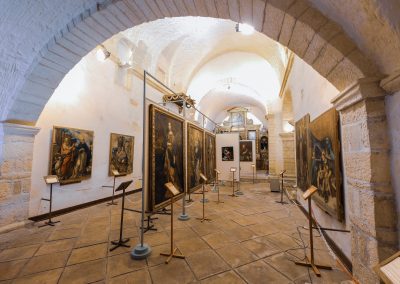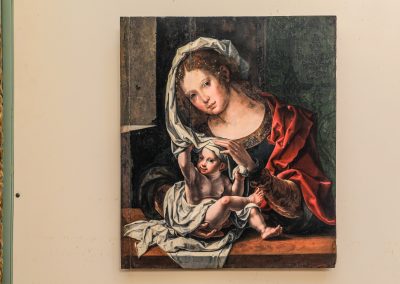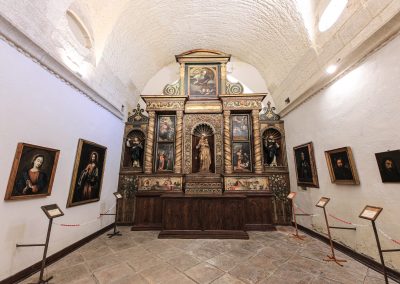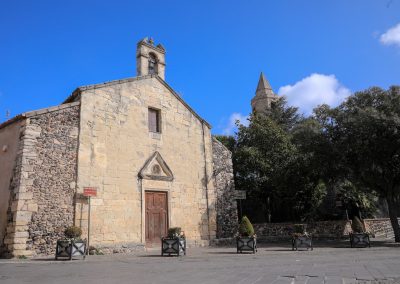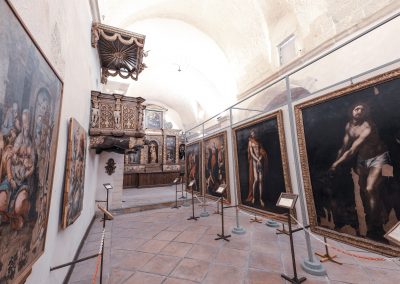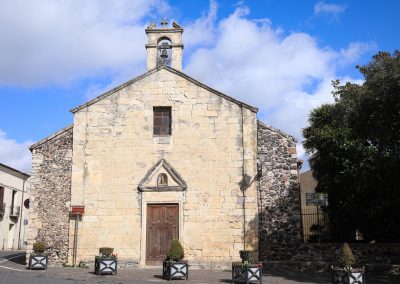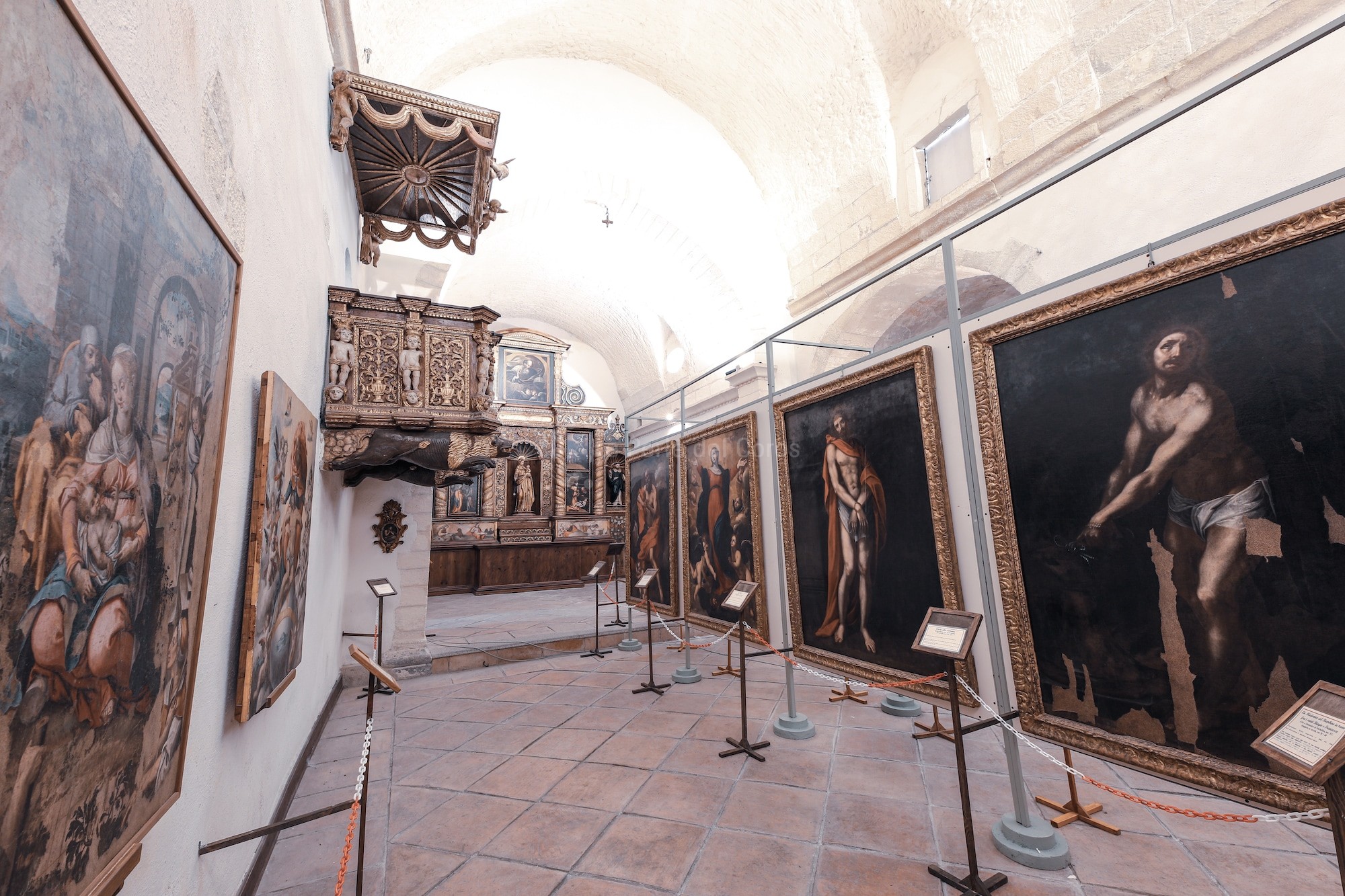
Ploaghe
The Oratory of the Rosary
The Oratory of the Rosary occupies the left extremity of the square Piazza San Pietro and is dedicated to Our Lady of the Rosary, whose worship is heart-felt by the inhabitants of Ploaghe. The consecration date, 1651, is indicated on the façade in an epigraph in Logudorese, a variant of Sardinian. The oratory was renovated between 1983 and 1988 thanks to funding from the Ministry of Environmental, Architectural, Artistic and Historical Heritage. In fact, the prolonged abandonment had compromised the structure due to water infiltration.
The building is typical of architecture recurring throughout the 17th century: a single nave with seating area, a sacristy on the left and a lateral chapel on the right; the main body has a barrel vault; and the internal wall is plastered with some stone elements left in view. Externally, the front is made in limestone ashlars and has a double pitched roof. The main entrance is in the lower part of the façade, with an architrave surmounted by a Classical style pediment, and in alignment with a window that allows an intense light to penetrate inside. Inside, there is also a choir, where there used to be a pipe organ.
There are two altars, one in the nave, the other in the chapel, and a pulpit, all wooden structures considered of great artistic value. The main altar has only one order subdivided into five sections by twisted columns, three have niches and two have paintings portraying stories of the Virgin Mary and Christ. In the lateral niches, there are the Dominican saints, Dominic and Vincent Ferreri, while in the central one, is The Madonna and Child. Above the altar table there are representations of the four Evangelists and on the sides there are two panels with rose motifs, directly referring to the Virgin Mary. The altar culminates at its apex with aedicule where a painting with “the Eternal Father” is located. Its structure derives from the retables of the 16th century altars (tn* a retable is an ornamental screenlike structure above and behind an altar, especially one used as a setting for a religious picture or carving). The minor altar displays the same artistic style; it has a section with a niche where the statue of Saint Veronica is located. On the sides it has paired twisted columns that support the trabeation with frieze. Adjacent to the chapel there is a rectangular-shaped pulpit, supported by lions. The parapet is subdivided by putto-Caryatids in frames decorated with vases containing coils of acanthus. In the central frame there is the emblem of the Dominicans, representing a dog with a torch in its mouth. The panels above the table show the Evangelists according to their traditional iconography, accompanied by their usual symbols: the angel for Matthew, the ox for Luke, the eagle for John and the lion for Mark. The other three canvasses depict stories of the Virgin Mary and an episode referring to Christ: that is the first three episodes of the Joyful Mysteries and the first of the Painful Mysteries: The Annunciation, the Visitation, the Nativity and Christ in the Garden of Olives. At the top, there is a representation of the Eternal Father. The scenes have a simple structure focusing on the key characters of the Gospel’s stories, in the Nativity and in the Garden of Olives there is also a glimpse of landscape. The scenes are characterised by naturalness, elegance and poetry.
At the Oratory of the Rosary, one of the most important art collections of Sardinia is displayed, numbering 60 paintings. It belongs to the Parish and is known as the Spano collection. Its origin dates back to 1780 when ten big paintings were bought by the Rector Demurtas to decorate the halls of the Rector’s house. In 1873, the collection was enlarged by the donation from the Canon Spano, and later by works from the parish and churches connected to the ex-Capuchin convent. The paintings that date back from the 14th to the 15th centuries, document the existence of various local, Italian and European artistic schools. The earliest, a tempera on panel of Tuscan school, dates back to 1340. It shows Saint Dominic and was recently attributed to Francesco di Volterra. Among the main works is “Saint Francis’s stigmata” (16th century) by Piero Cavaro from the school of Stampace; the “Holy Family” (16th century) from the Masters of Ozieri; “The Virgin with Child” (16th century) attributed to the Dutch painter Paul Coecke; “The Adoration of the Shepherds”, the Saints Jerome and Dominic, the Holy Trinity (from the first twenty years of the 17th century) are by Francesco Pinna. At the moment, the collection is divided between the Oratory of Our Lady of the Rosary, where the permanent exhibition has been since 2001, and the Rector’s House.
The building is typical of architecture recurring throughout the 17th century: a single nave with seating area, a sacristy on the left and a lateral chapel on the right; the main body has a barrel vault; and the internal wall is plastered with some stone elements left in view. Externally, the front is made in limestone ashlars and has a double pitched roof. The main entrance is in the lower part of the façade, with an architrave surmounted by a Classical style pediment, and in alignment with a window that allows an intense light to penetrate inside. Inside, there is also a choir, where there used to be a pipe organ.
There are two altars, one in the nave, the other in the chapel, and a pulpit, all wooden structures considered of great artistic value. The main altar has only one order subdivided into five sections by twisted columns, three have niches and two have paintings portraying stories of the Virgin Mary and Christ. In the lateral niches, there are the Dominican saints, Dominic and Vincent Ferreri, while in the central one, is The Madonna and Child. Above the altar table there are representations of the four Evangelists and on the sides there are two panels with rose motifs, directly referring to the Virgin Mary. The altar culminates at its apex with aedicule where a painting with “the Eternal Father” is located. Its structure derives from the retables of the 16th century altars (tn* a retable is an ornamental screenlike structure above and behind an altar, especially one used as a setting for a religious picture or carving). The minor altar displays the same artistic style; it has a section with a niche where the statue of Saint Veronica is located. On the sides it has paired twisted columns that support the trabeation with frieze. Adjacent to the chapel there is a rectangular-shaped pulpit, supported by lions. The parapet is subdivided by putto-Caryatids in frames decorated with vases containing coils of acanthus. In the central frame there is the emblem of the Dominicans, representing a dog with a torch in its mouth. The panels above the table show the Evangelists according to their traditional iconography, accompanied by their usual symbols: the angel for Matthew, the ox for Luke, the eagle for John and the lion for Mark. The other three canvasses depict stories of the Virgin Mary and an episode referring to Christ: that is the first three episodes of the Joyful Mysteries and the first of the Painful Mysteries: The Annunciation, the Visitation, the Nativity and Christ in the Garden of Olives. At the top, there is a representation of the Eternal Father. The scenes have a simple structure focusing on the key characters of the Gospel’s stories, in the Nativity and in the Garden of Olives there is also a glimpse of landscape. The scenes are characterised by naturalness, elegance and poetry.
At the Oratory of the Rosary, one of the most important art collections of Sardinia is displayed, numbering 60 paintings. It belongs to the Parish and is known as the Spano collection. Its origin dates back to 1780 when ten big paintings were bought by the Rector Demurtas to decorate the halls of the Rector’s house. In 1873, the collection was enlarged by the donation from the Canon Spano, and later by works from the parish and churches connected to the ex-Capuchin convent. The paintings that date back from the 14th to the 15th centuries, document the existence of various local, Italian and European artistic schools. The earliest, a tempera on panel of Tuscan school, dates back to 1340. It shows Saint Dominic and was recently attributed to Francesco di Volterra. Among the main works is “Saint Francis’s stigmata” (16th century) by Piero Cavaro from the school of Stampace; the “Holy Family” (16th century) from the Masters of Ozieri; “The Virgin with Child” (16th century) attributed to the Dutch painter Paul Coecke; “The Adoration of the Shepherds”, the Saints Jerome and Dominic, the Holy Trinity (from the first twenty years of the 17th century) are by Francesco Pinna. At the moment, the collection is divided between the Oratory of Our Lady of the Rosary, where the permanent exhibition has been since 2001, and the Rector’s House.
Source: website of the Town Council of Ploaghe, book “Church and Institutions” (in Italian), by Gavino Spanedda
- Tomb of the Giants Fiorosu
- The Candelieri
- Church of Saint Peter
- Church of Saint Anthony of Salvennor
- Church and convent of Saint Anthony of Padua
- Church of Saint Michael of Salvennor
- Monumental cemetery
- Funtana Manna (tn* Big Fountain)
- The Oratory of the Rosary
- Church of Saint Matthew
- Nuragic Fountain of Frades Mareos

